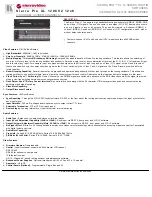
Section 6: Instrument programming
Models 707B and 708B Switching Matrix Reference Manual
6-36
707B-901-01 Rev. A / August 2010
Script Editor
The script is written and modified in the Script Editor. Notice that there is a tab available for each
opened script file. A script project is then downloaded to the instrument, where it can be run.
Programming interaction
Up to seven tabs can be displayed in the lower pane of the workspace (the script editor) to provide
programming interaction between the Test Script Builder and the instrument. The instrument console
shown in Using Test Script Builder (TSB) is used to send commands to the connected instrument.
Retrieved data (for example, readings) from commands and scripts appear in the instrument console.
Advanced scripting for TSP
Global variables and the script.user.scripts table
When working with script commands, it can be helpful to understand how scripts are handled in the
instrument.
Scripts are loaded into the runtime environment from nonvolatile memory when you turn the
instrument on. They are also added to the runtime environment when you load them into the
instrument.
There are several types of scripts in the runtime environment:
•
Named scripts
•
Unnamed scripts
•
The anonymous script
When a named script is loaded into the runtime environment:
•
A global variable with the same name is created to reference the script more conveniently.
•
An entry for the script is added to the
script.user.scripts
table.
When an unnamed script is loaded, a global variable is added. Nothing is added to the
script.user.scripts
table.
When the anonymous script is loaded, it does not have a global variable or an entry in the
script.user.scripts
table. If there is an existing anonymous script, it is replaced by the new
one.
When the instrument is turned off, everything in the runtime environment is deleted, including the
scripts and global variables.
See the figure below to see how the scripts, global variables, and
script.user.scripts
table
interrelate.
















































